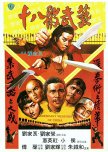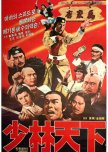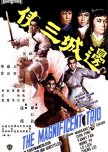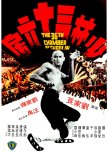
When nuclear testing causes disturbances across the area, including the underwater world of Seatopia, their leader, Emperor Antonio, clad in a white toga with go-go boots and wearing a tiara with what looks like a replica of Megalon's head, calls for the giant cockroach to appear and retaliate against the humans. Megalon heads to Tokyo and starts tearing things up in town.
Meanwhile back at a Japanese lab a couple of humans and a kid are admiring the new robot they've created, Jet Jaguar, which was likely brought in to make the movie even more kid friendly. It reminded me of a creepy clown Ultraman. A couple of Seatopians show up and the kidnappings begin because they want the robot technology.
Ultimately, Jet Jaguar and Godzilla team up against Megalon and Gigan. It takes until two thirds of the movie to get the monster action going but when they do the fun begins. There are monster high fives and handshakes, dispelling any notion that these are giants guided by instinct.
When Godzilla shows up, the music doesn't announce a scary monster, it sounds more like someone's drunk Uncle Tony is stumbling onto the scene. The music was not very inspiring in this movie.
A giant cockroach seems apropos as a mortal enemy, they were here long before humans and will likely be here long after humans. I've always thought they'll be the ones to take over once we're gone in the hopefully very distant future. Thankfully, this time a giant irradiated lizard was able to keep cockroach world domination at bay.
Was this review helpful to you?

I'm going to start off with what I liked. The quality of the miniatures, sets, 1968 special effects, and space ship was quite good. I had to remind myself that this movie came out a year before the first manned trip to the moon. I appreciated their optimism that the world would be fully cooperating in 1999 not just on Earth but the moon as well. On the monster front, eleven popular Kaiju stars made appearances: Godzilla, Mothra, Rodan, Mandan, Kumonga, Baragon, Varan, Gorosaurus, Minya, Anguirus, and Ghidorah. The fight near the end was all you could hope for in this era from Ghidorah against Godzilla and friends.
What let me down about this movie-in a movie called Destroy All Monsters, I want to see monsters. I suppose it could have been talking about the aliens because out of 88 minutes, the monsters were only on screen for around 18 minutes. The alien story could have been interesting but the acting was stiff and unemotional from humans and aliens alike. There were some entertaining moments, but not enough to keep me from wondering what the monsters were up to while the humans were talking.
Even though I was happy to see all the monsters in one movie, it would have been nice if they'd felt like the stars instead of guest stars in their own movie.
Was this review helpful to you?

Based loosely on the time when foreigners with guns were invading China, there were those who thought their fighters would be able to repel bullets with their kung fu. Lau Kar Leung's character disbands his school because he doesn't want to see any more young men die trying to survive bullet wounds with kung fu techniques. Of course, now he's branded as a traitor and the other schools send people to execute him. He's living quietly as a woodcutter though it doesn't take long for Hsiao Hou and Kara Hui to track him down. Kara's character is in agreement with his philosophy, Hsiao's character ends up having to question all his training and loyalty to his master when confronted with the truth of the human body and bullets.
There are some magical elements to the action with mind and body control. Two scenes with Alexander Fu Sheng, who plays a local conman, are particularly funny with Lau Kar Leung controlling his body with a straw doll.
Aside from Kara Hui, this is not a movie with pretty actors in the lead roles. This movie was made with actors, including Kara, who could perform the fights with precision and grace.
I could go on about the clash of traditionalism vs modern warfare and the nature of kung fu touched on in the film, but honestly what I enjoyed the most was watching the amazing fight scenes. Lau Kar Leung vs Hsiao Hou. Hsiao Hou and Kara Hui in a crazy attic fight. Gordon Liu, here in a supporting role as the antagonist, fighting against Lau Kar Leung was great. Just watching Lau Kar Leung practice with the weapons was worth the price of admission. The best was literally brother on brother fighting when Lau Kar Wing and Lau Kar Leung fight using all 18 weapons and their fists and kicks. The fighting is fast, expertly choreographed, no obviously missed hits or kicks, no missed timing. It was a joy to behold watching these experts put on a show.
After all the thrilling fights, the story even came to a satisfying end. If you are a kung fu movie enthusiast, this one is not to be missed.
Was this review helpful to you?

Mechagodzilla is back and this time it's personal!
Godzilla has his claws full battling a refurbished Mechagodzilla, Titanosaurus, and the space aliens from the previous Mechagodzilla appearance. This time the aliens have a mad Earth scientist who can control the normally peaceful Titanosaurus to help them reach their nefarious goal of leveling Tokyo and making it their new home. Along for the ride are some Interpol agents and the mad scientist's cyborg daughter. Of course, one of the Interpol agents falls madly in love with the daughter in the five minutes he gets to know her. Godzilla movies have it all--even romance!I thought the first Mechagodzilla movie was better than this one. Godzilla was almost relegated to a bit player here. He had a face lift since his last outing, making him look angrier. Thankfully, his eyes didn't look painted on by a fourth grader this time. Titanosaurus had the most screen time. I have to say I thought the design for Titan was very good and aesthetic, he made a formidable, if reluctant opponent for Big G. Mechagodzilla was back with some new weaponry and a few surprises.
Ifukube Akira's score was dark, ominous and at times thundering. I very rarely notice the music in movies, but I thought the score was nearly perfect, particularly for the opening sequence.
I would be remiss if I didn't make note that Honda Ishiro, the director for the first Godzilla movie, came out of at least semi-retirement to helm this movie.
The monster fights and city destruction were well done and didn't go over the line into the boxing camp of earlier movies. It did look like the same city block was destroyed several times, but given it's smallish budget that feels like nitpicking. My complaint is the same one I give in nearly every review, the humans were lackluster, including the simian aliens. The human element wouldn't be as important if they didn't take up so much screen time. I'm here for the big guy, not the humans he lets live on the island.
Terror of Mechagodzilla was entertaining, with a few dark elements thrown in, particularly near the end. This was a slightly above average 1970's Godzilla movie for me.
Was this review helpful to you?

Big G has his hands full with Mechagodzilla, luckily King Caesar/Shisa and some plucky humans are around to help. Returning for another Godzilla adventure is Hirata Akihiko as Professor Hideto Miyajima. This veteran actor is always a welcome presence. The humans were fairly interesting in this movie as they dealt with the aliens in various dangerous, if convoluted scenarios.
Though made during the classic 1970's rubber suit era, the makers of this film backed off the camp and upped the danger for Godzilla, complete with spurting blood. I have to remind myself that these movies were often made to be kid friendly though they did tone down the humorous fight scenes in this one. The laser effects were good for this time-frame and for what looked like a movie that was shot on a very limited budget. No miniature armies appeared, only buildings and mountainsides were destroyed. This was strictly monster on monster fighting.
Many Godzilla movies have a moral behind them. In this one, King Caesar/Shisa seems to be a call back to older Japanese traditions where the priestess must sing a hymn to awaken him. He is the god-like creature who protects the island and appears when called upon. Mechagodzilla shows modern technology encroaching on society. And somewhere in between is Godzilla, an ancient creature enhanced by modern nuclear radiation. Or maybe I'm reading too much into it and King Caesar is just a giant dog eared monster, Godzilla is a giant, destructive lizard and Mechagodzilla is just a large tin can created by some aliens spoiling for a fight!
Mechagodzilla's suit and weaponry were innovative though the real Godzillas's suit was underwhelming for me in this one. This is one of the rare times I enjoyed the humans' story as much as the monster fights. That's not to say their story was riveting, perhaps it's more of a reflection of my apathy toward the monster fights. I found King Caesar/Shisa to be lacking in particular. Mechagodzilla's weaponry and fights with Big G and all the spies both alien and human running around kept the film interesting and the action moving forward. Not a bad way to spend 90 minutes if you are a fan of the classic era.
Was this review helpful to you?

The story had some fun twists and turns. There were corrupt Ching nobles, Ming rebels, Korean sympathizers, Japanese characters, monks, fake monks, and real monks in disguise all after a pearl that is a holy relic, but there's also a fake pearl and a poor dead body dragged around the country side. With all these moving pieces, of course there are double crosses galore.
The story had potential, unfortunately some of the best fighters were missing for big chunks of time during the movie. Angela Mao doesn't appear until the 30 minute mark and Carter Wong is also vastly underused. Paul Chu plays the ML and he is out classed by the kung fu fighters around him and it shows.
The soundtrack often sounded like spaghetti western music and I suppose with all the outdoor settings and classic good guy versus bad guy fights only with fists or swords instead of guns it was fitting.
Many kung fu movies end abruptly as if the crew ran out of film but this one had a particularly unsatisfying ending. The saving grace for this film was simply being able to see the cast in action even if they were often underutilized. Legendary Strike may not be legendary but it did have some entertaining moments.
Was this review helpful to you?

This review may contain spoilers
Godzilla is nearing death not only for himself but possibly all of humanity as his nuclear heart is about to explode. If that wasn't enough to deal with, Japan's G Force must also contend with some truly scary monsters created from the original 1954 Godzilla weapon-the oxygen destroyer-that have reached maturity and come ashore. Though we are still in the rubber suit era, the CGI and miniatures are quite good for this time and budget. The Destoroyah describes a number of ten foot tall monsters that look like a cross between Alien and the creatures from Starship Troopers, or giant creepy scorpions that can also shoot laser breath out. Their battle with humans in a building were probably the scariest scenes I've seen in the old G movies. The danger and stakes were immediate and personal. When a reporter is trapped in a car with a Destoroyah after her it's more compelling than when unseen humans die in buildings and cars crushed by the giant monsters.
The story for this movie is strong when it focuses on the monsters. Godzilla's son appears and fights Destoroyah, drawing Godzilla back for a final battle. The fights are good, resisting the camp of older movies.
The weak spot in this movie is as usual, the humans. This group was a particularly bland group of actors and flat characters. The one bright spot was a call back to the original Godzilla movie when Momoko Kochi reprises her 1954 role as Emiko Yamane. Ultimately, the monsters showed more believable anger and grief than the humans.
The OST for this movie was particularly good for a Godzilla movie evoking emotions and blending appropriately with the scenes. Probably the best music from any of the Godzilla movies I've watched.
Aside from the acting, the biggest problem I had with this movie was that the narrative and pacing were not always coherent or cohesive. There were times I wasn't completely sure what was going on. At others, it felt like parts of the story had been forgotten.
The movie makes a nice circle back to the original which is fitting as this was to be the last in this series. Godzilla fights one final monster, maybe his greatest enemy yet, before his punishing finish for Tokyo.
Was this review helpful to you?

The plot is not very deep. The evil lord needs a rare medicine and sends Lo Lieh and his deadly dragon missiles to get it. The evil second in command wants the glory and rewards so he sends henchmen to "escort" LL. Along the way innocents are killed and family members come seeking revenge. There are crosses, double-crosses and triple-crosses all with LL in their cross-hairs. Very few minutes go by without weapons being drawn and red blood or heads flying.
Several of the fight scenes take place outdoors in beautiful settings near the ocean. Some of the stage sets will seem familiar to Shaw viewers. The fights are adequate for this cast, not super fast but entertaining.
The plot was thin, the sound effects could have come straight out of a Warner Bros. cartoon, and as always the Shaw Bros. ending was hilariously abrupt, but it was a fun 80 minutes of fights, chases, and betrayals.
Was this review helpful to you?

This review may contain spoilers
This sequel to the beautifully made Come Drink With Me should have been called Silver Roc instead of Golden Swallow. The amazing Cheng Pei Pei, the star of CDWM, is relegated by director Chang Cheh to a supporting role in her own movie in favor of Jimmy Wang's Silver Roc.The story sets up an unhealthy love triangle. The Roc is a ruthless killing machine cutting and slashing his way across the country taking out anyone affiliated with a gang or evil family. The problem comes in when he frames the Golden Swallow for the killings bringing down all sorts of trouble on her head. Fortunately for her, Lo Lieh shows up as the Golden Whip saving her after she's been poisoned and protects her while she heals. The two of them fight side-by-side together and become friends though The Whip is falling in love with her. Meanwhile the Roc spends all of his non-killing time at the brothel.
Why did the Roc set her up repeatedly? He and the Swallow had known each other at their martial arts school years ago and he would occasionally speak to her even though he was a jerk to everyone else. Now he's trying to force her to come to him with the bad guys hunting her down relentlessly even though he's known where she is all along. I don't begin to know how to reconcile her having feelings for a man who kills mercilessly and puts her life repeatedly at risk out of "love". These aren't spoilers, it's literally the plot for the whole movie. It's that basic.
Wang is seen several times riding a horse and he rides like he wields a sword-sloppily and as if he'd never done it before. Normally, Lau Kar Leung is my favorite fight choreographer, but he missed severely with this movie, maybe it was Tang Chia's influence. Wang's ultimate swordsman abilities are akin to spray and pray with everyone falling down. In CDWM Pei Pei's moves were artistic, here they are rudimentary and she keeps having to throw her hands up like a cheerleader. Lo Lieh manages to look smooth and powerful which only accented Wang's frenetic movements. It didn't help that Wang's acting was stiff as a board in this movie.
What I did like were Pei Pei's and Lieh's performances. They came across more naturally bringing some depth and nuance to scenes that bordered on the ludicrous. Wu Ma played a good guy for a change and he was able to show what he can do with a few lines and scenes.
I know I'm coming across as harsh, but watching Come Drink With Me and Golden Swallow back-to-back was a mistake because the difference in quality and style was glaring. Chang Pei Pei commanded the screen in CDWM, in Golden Swallow she was stuck playing the vacillating female over someone who kills and threatens to get her attention. Wang's character took up most of the story which is a shame because he was the least interesting thing about the whole movie. I would have scored GS lower, but gave it a bonus point bump for Cheng Pei Pei's and Lo Lieh's diligent work to save this story.
Was this review helpful to you?

Gordon Liu plays the 11th prince, and soon to be named Crown Prince, who has to hide his martial arts skills and his identity as he tries to find out which brother is trying to have him killed. He takes on a hot-headed thief named Ho, played by Wong Yu, through some subterfuge and trains him in kung fu and how to be a better man. The growth of their relationship from adversaries to friends is at the heart of the story. The movie starts out as a light comedy and steadily grows darker.
In Liu's initial fights he disguises his skills making it seem that what happens are accidents or like a puppet master fights through someone else. In two other "polite" encounters with killers, a wine tasting and antiques buying expedition, he fights calmly and intricately with the polite killers without damaging the products. Ultimately, there is a no holds barred showdown with Lo Lieh, playing the corrupted general along with his minions.
For fans of Shaw Brothers productions there are many familiar faces filling out the cast. The biggest star for me was the man behind the camera, Lau Kar Leung. His fight choreography, especially in the days before CGI, is amazing. Fortunately, for him, he had some actors well versed in kung fu to bring those scenes to life.
Was this review helpful to you?

Initially Jimmy Wang Yu, the main hero, is on his own with a few towns people who are trying to get a petition to the magistrate's overlord to bring justice to the town. Lo Lieh works for the magistrate but though a skilled swordsman is not into his work. Cheng Lei starts out in prison where he got himself incarcerated just so that he has food to eat. An unlikely trio find their way on the same side during the course of the movie.
The story starts out slow and repetitious, the sword fights rather dull and uninspired. The bodies start piling up as the movie goes along and Jimmy Wang Yu's character dances a fine line between being heroic and ineffectual. Eventually, the sword fights improve but were not memorable. The story does pick up as well as more and more people are galvanized into action.
Magnificent Trio has been re-mastered, the colors and clarity are vibrant. The music and sound effects came through clearly.
The subtitles were easy to read as well. It's worth mentioning because some of these older films have been neglected and treated poorly. The colors can be faded and the subtitles can run right off the screen. Thankfully, MT was lovingly restored.
I didn't find Magnificent Trio thrilling and the fight scenes were okay. What I did like was the chemistry between the three heroes and the sacrifices they were willing to make to better the lives of others. Overall I enjoyed the movie though I doubt it's one I'll ever re-watch.
Was this review helpful to you?

I enjoyed this Godzilla movie because it's one of the few movies where the humans are actually interesting. Most of the time they are background noise. The writers took the time to develop three or four characters, giving us someone to root for, care for and also despise.
The alien ship was formidable enough but when the alien(s) aboard is able to siphon off some of Godzilla's DNA and create a monster body of his own, the big guy has his hands full. This movie used a variety of techniques to bring the monsters, spaceship and fights to life, including the signature miniatures Godzilla movies are known for. Too often in Godzilla movies there are a lot of boring filler scenes in between monster fights, Godzilla 2000 kept the action going among the monsters and the humans.
Despite its mediocre rating I found it entertaining from start to finish.
Was this review helpful to you?

This review may contain spoilers
I would love to have been in the writers’ room for this movie and seen what they were thinking and tripping on. Let’s make a monster environmentally conscious because it eats pollution. Far out! But it also sprays concentrated sulfuric acid on people and shoots toxic waste out of its belly button. Cool! We should also have some cartoons mixed in with the action. Groovy! And go-go dancing and singing randomly thrown in. I can dig it! Don’t forget some trippy dream sequences! Right on! We gotta have a guy hallucinating at a concert, too. Lay it on me!In fairness, this was a fun Godzilla movie with a formidable enemy for the big guy. Hedorah can grow and change shape the more he feeds on pollution. He flies, Godzilla even flies!
Even though there are some psychedelic moments, there are also real stakes in this movie. Main characters are maimed and killed by Hedorah. The stakes were also high for the environment. Real images of the disturbing amount of pollution in Tokyo Bay are shown as the theme song is sung. Pollution was becoming a very real concern and, in this story, spawned a deadly monster.
There is plenty of monster-on-monster wrestling. They might have spent too much time taunting each other and Godzilla takes a beating more often than not for most of the movie, but we know we can always count on him to rally in the end and take care of business. If you are a fan of the old school Godzilla, this is one of G’s more unique films. Outta sight!
Was this review helpful to you?

A good third of the movie is devoted to Gordon training through the 35 stations at the Shaolin temple. The scenes are rigorous and impressive. Lau Kar Leung (Gordon Liu's brother IRL) is one of, if not my favorite martial arts choreographer. No slow stop action fight scenes or training scenes. While the scenes are slowed down for the human eye to follow, the movement is constant. A wide variety of weapons and challenges are used which highlight Gordon's abilities. The only caveat I have is that like a novel's page needs some white space to rest the eyes, I could have used some breaks from the action to develop the main character and give me more reasons to understand him, the people he sought to help, and the monks who trained him.
The sets, costumes, and production values are above average for a 1978 kung fu film. The copy I saw was dubbed which always takes away from the viewing experience. Almost any male actor who worked for Shaw Brothers was in this movie. It was fun to pick out all the ones I knew.
One of my favorite kung fu actors, Lo Lieh, plays the Big Bad though he sees very little screen time. This is Gordon's hero's journey. Through training and sacrifice his character seeks to avenge his family's death and bring kung to his people so that they can protect themselves from the enemy. A better than average kung fu film to pass your time with.
Was this review helpful to you?

Considered a kung fun classic, I found it to be rather average. Lau Kar Leung's direction and martial arts choreography saved the film for me. The fights were well choreographed and creative without looking overly staged. It helped that some of the better kung fu actors starred in this movie: Lo Lieh, Chen Kuan Tai, Lily Li, Wong Yu, Chiang Tao, and Gordon Liu.
The plot revolves around revenge and training, taking place over twenty years. There are a lot of gaps in the storytelling. Fortunately, the training sequences are entertaining and well done. It does have one of the most abrupt Shaw Brothers endings ever. Due to the choppy style of storytelling it's not a movie I'd recommend unless I knew the person enjoyed well done fight sequences.
Was this review helpful to you?

 54
54 195
195 11
11






















